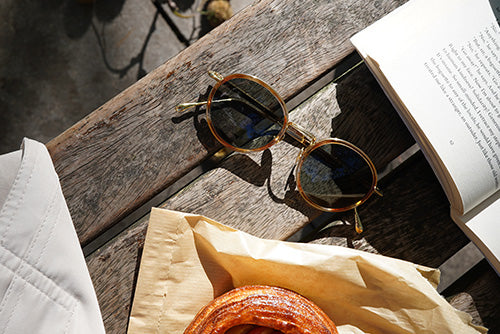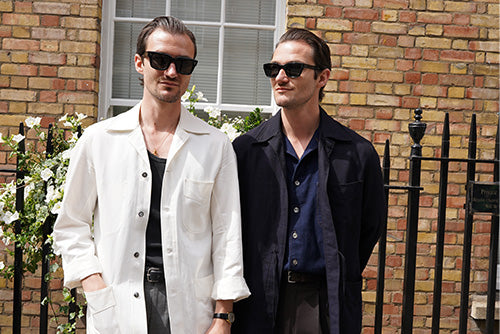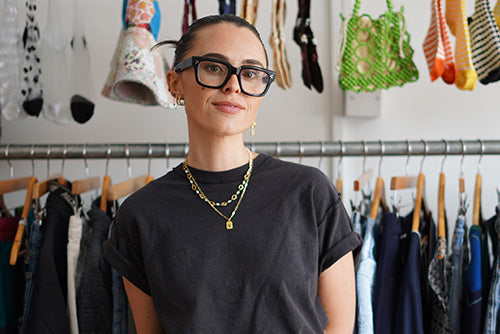Rosie Okotcha, In The Frame

Rosie, it's so nice to be spending the day with you at the V&A, for those who might not know you, please can you introduce yourself?
I'm Rosie, I'm a fashion historian and sustainability content creator. I'm kind of obsessed with history, which is funny because growing up I always thought it was really lame, and now as an adult, all I wanna do is read more about it. I also have a podcast with one of my closest friends called Spill the Sustainability where we talk about all things sustainable, and any of the pop culture news that links in with that.

-
You did your bachelors degree in Art History and then went on to complete your MA in Fashion Communication History & Theory, what inspired you to take this route?
Weirdly, I never actually wanted to go to university but then I learnt that I could actually study art history, and I love painting and I love all that kind of thing, but I've never really thought of myself as much an artist, I just love the culture around it.

My course was focused on visual cultures and a lot of it discussed decolonizing art industry. I wrote my thesis for my BA on, fast fashion and colonialism, and I tracked a garment from it's fibres to where it then ended up in landfill.

-
As an educational content creator and consultant, how do you come across the subjects you choose to research? What does your research process look like and what do you enjoy most about it?
It's funny, I was writing something this morning and I realised so much of my thinking is done in bed. I'll often wake up in the morning and I'll grab my laptop or it will be just as I am falling asleep, I have an idea or something like that.
It's interesting also because a video I did on Victorian mourning jewellery (click here to watch it) did really well and I remember recording it and thinking no one cares about this - I really care about this, but nobody else is going to. And then people really cared! So I've also realised that although it's good to address things that are trending, I've also noticed that if I'm really passionate about it, it's better to just go with that - follow the things you're passionate about. And at the moment I really loved, I mean I've always loved the Victorian era. I love pre-raf art and the weird obsession with death and the sort of lustiness of of that era.

Ophelia by Sir John Everett Millais
We couldn’t agree more, if you’re sharing something with passion, people pay attention. Could you tell us what mourning Jewellery is?
Yes! So it's got human hair and different things like that in it. It’s one of the weirdest things, you used to get it when the person was still alive. So imagine a relative was on their deathbed, they would cut a lock of their hair and turn it into jewellery.
But there was a lot of like scandal with people receiving the wrong hair and things like that because people would send their hair off to get it plaited and then it would get mixed up and people would receive the wrong hair back.

Image of Victoria Mourning Jewellery via Pinterest
-
There is no denying that art and fashion reflect the political or social climate of their time. Can you give one example of when this felt the most the most obvious within history and one example of how this is manifesting in today’s society?
I was thinking about this recently, and I actually made a video on it (you can watch it here). I was looking into the fact that there's something called the hemline index. So basically, depending on whether the country's thriving economically or not, our skirts get shorter. So if we're thriving and feeling like flirty and rich, then our skirts get shorter, but then in times of recession, our skirts get longer, like in the 1960s with Mary Quant the skirts got very, very short, and then in the 70s, they got longer again because the economy wasn't thriving in the same way.

Pictured left, Mary Quant Mini Skirt, Pictorial Press Ltd / Alamy Stock Photo | Pictured right, Protests in favour of the mini skirt, Larry Ellis/Getty Images

And even in the 1920s, hemlines got shorter. Also, bag size gets bigger during recession because people want better value for their money, so are more likely to get like a larger bag than a smaller one.

Pictured above, Jacquemus Chiquito Bag FW19
-
I've also been thinking a lot about boho fashion appearing in times of more conservative political states, for example, in the 1960s there was obviously, a lot of things, many, many things going on in the 1960s and because of that, the hippie movement appeared and then even in the 19th century, with the industrial revolution, sort of bohemian like pre-raf lifestyle became a thing, and I think we're kind of seeing it a little bit now, although I guess it's more complicated because now we've got true boho appearing and emerging as a reaction to politics, but we've also got conservative ideologies sort of pretending to be bohemian lifestyles. So I think it's very interesting how it sort of developed through time. I did a video on boho not so long ago.
Click here to watch Rosie's Video on the History of Boho.

Pictured Left, John William Waterhouse, La Belle Dame sans Merci, 1893 | Pictured Right, Chloe F24 Runway Look
-
In 2025, the internet has created a more interconnected fashion world then ever before. How do you feel our hyper-globalised landscape is effecting fashion?
I think with the globalisation of fashion, it's very interesting because although it's ‘worldwide’, it's actually not, I think it's still very based on colonial powers, the main fashion capitals being in Europe and then America, and I think so much of the world which is creating incredible art and clothing is completely left out. So I feel like there's an the idea that the fashion industry's become very globalised, but whether it actually has is a completely separate question.
I think through social media and the internet, the fashion industry has become more widespread and accessible, so I guess that's good. But I think it's also created a lot of weird little niches. I wouldn't even call them necessarily subcultures. I guess it's micro trends, for masquerading as subcultures.
-
On a related note, fashion is famously cyclical - why do you think certain trends keep coming back, and what do you think triggers their return?
Fashion cycles are 30 year cycles and I was actually in a vintage shop the other day and I was talking to the owner and she was saying that she finds that when people come in looking for things, she asks what decade they were born in, and then she'll give them items of clothing from then, and she says that's what suits them best, which I thought was really interesting. But I think that trends keep coming back so fast now because we've got such easy access to old runways and archives.
It's never been easier to access data from the past. So I think with that and also with a very turbulent future ahead of us, there's no reason why we'd particularly want to be looking into that. So I think it’s a way of feeling safe and secure in a sense it’s staying nostalgic and looking back at the past, looking back with rose tinted goggles. So I think that also speeds up trend cycles a little bit like his fear for the future.

And then of course there’s the internet and fast fashion. Zara's got hundreds of thousands of products on their website and they keep producing more. So I think with fast fashion making things so quickly, people get bored faster, and people think of fashion in a different way than they once did. Like, it's more disposable and the less of an art moment that we wear on our body and more of a throwaway item. With people's perspectives on fashion becoming more throwaway, the trend cycles have also sped up.
-
Recently, we've seen an explosion of aesthetic-driven 'core' trends - cottagecore, gorpcore, balletcore - where do you think this fascination comes from, and what do you believe it says about our society? Do you see these ‘core’ aesthetics as playful escapism, a modern attempt on subcultures (such as punks, skinheads, mods) - or something else entirely?
I'm screaming on the inside when it comes to cores, I think that people misconstrue them as being subcultures where actually subcultures are highly based in culture and building a community around something like music or art, whereas micro trends or cores are very often based purely on the aesthetics and not anything to do with the culture around the thing, like clean girl or tomato girl.
I think when they come with community connection, they see more longevity. For example, I think Gorp core comes with building a community, I've noticed many people who get into that aesthetic go to a lot of community walks or hikes, and I think that's what can then take you from being a core to a subculture.
But most cores have more of a negative impact than a positive one, and come with people over consuming cheap clothes rather than getting involved in community activities and like building a culture around a thing that they love altogether, if that makes sense.
-
Are there any current ‘cores’ that you find particularly interesting from a historical perspective?
It's funny because this makes me very hypocritical, because I just dissed cores so bad, but I do really like medieval core, but I guess in my mind, the reason I like medieval core is because of the history around it, and I find something really fun and playful and welcoming about it. I don't feel like it's centred in buying new stuff, so much of it is how you style something. I haven't seen any brands that really can really replicate medieval core clothing, it's so based on perspective and whether you understand the little nuances, even things like the buttons. I really like that because I feel like it invites playfulness, it invites rewearing things, it invites up-cycling and getting a little bit weird, like fancy dress vibes, which I feel like is actually in a sense, a departure from what many of the other cores promote, which is just over consuming cheap things.
Watch Rosie's Medieval Core GRWM here.

Medieval Tapestry Hanging in the V&A
-
We have so many questions that we’d love to ask you, but we only have time for one more, so we’ll end on a fun one… We usually ask our guests which three people - past, present, or even fictional - they’d invite to a dinner party... but today, we want to mix it up: Whose wardrobe, past present or fictional would you love to borrow from?
If I could raid someone's wardrobe past present or fictional, it would be Marie Antoinette. I just need to get in there, I need to know what's going on and see her dressing chambers, the bedroom, everything.
So I think I'd pick her. Definitely not close to French Revolution time though.

Pictured above, Kirsten Dunst as Maria Antoinette, directed by Sofia Coppola
Click here to explore Rosie's frame of choice - Brera in Quartz



